Not knowing anything about your schema or the shape of your data, you can get what you want by simplifying your query. Assuming a roughly standard-compliant SQL dialect
You don't need the enclosing select. A full select (unioned select expression) takes order by and that order by applies to the entire full select.
You don't need the distinct keyword on the individual select statements in the union: union by itself eliminates duplicate rows.
And please, when you write a long complicated query, spend some time formatting it so the next sod (who might be you a few years hence) who has to comprehend it can do so easily.
That gets you to the equivalent:
SELECT cards.id ,
cards.name ,
cards.created_at ,
cards.updated_at
FROM cards
INNER JOIN card_process ON card_process.card_id = cards.id
INNER JOIN processes ON processes.id = card_process.process_id
INNER JOIN category_process ON category_process.process_id = processes.id
INNER JOIN categories ON categories.id = category_process.category_id
INNER JOIN series ON series.id = categories.serie_id
INNER JOIN serie_user ON serie_user.serie_id = series.id
AND `cards`.`type` NOT IN ('', 'libraries')
AND NOT `cards`.`deleted`
AND NOT `categories`.`deleted`
AND NOT `series`.`deleted`
AND `cards`.`type` IN ('forms')
AND `series`.`id` IN (124,235,126,126,201,236,207,207,207,207,247,234,131,131,221,225,225,222)
UNION
SELECT cards.id ,
cards.name ,
cards.created_at ,
cards.updated_at
FROM cards
WHERE `cards`.`account_user_id`='9'
AND NOT `cards`.`deleted`
AND `cards`.`type` IN ('forms')
ORDER BY `updated_at` ASC
LIMIT 0, 25
If MySql doesn't allow limit on a full select, then you might need the enclosing select statement.
Also, one might note that your join criteria is almost certainly incorrect. In the 1st select, the join criteria for the table serie_user has a bunch of tests:
AND `cards`.`type` NOT IN ('', 'libraries')
AND NOT `cards`.`deleted`
AND NOT `categories`.`deleted`
AND NOT `series`.`deleted`
AND `cards`.`type` IN ('forms')
AND `series`.`id` IN (124,235,126,126,201,236,207,207,207,207,247,234,131,131,221,225,225,222)
They only apply to joining in the candidate rows from serie_user. They don't apply to the result set as a whole. They should be refactored into a where clause and into the join criteria for the pertinent tables, thus:
SELECT cards.id ,
cards.name ,
cards.created_at ,
cards.updated_at
FROM cards
INNER JOIN card_process ON card_process.card_id = cards.id
INNER JOIN processes ON processes.id = card_process.process_id
INNER JOIN category_process ON category_process.process_id = processes.id
INNER JOIN categories ON categories.id = category_process.category_id
AND NOT `categories`.`deleted`
INNER JOIN series ON series.id = categories.serie_id
AND NOT `series`.`deleted`
AND `series`.`id` IN (124,235,126,126,201,236,207,207,207,207,247,234,131,131,221,225,225,222)
INNER JOIN serie_user ON serie_user.serie_id = series.id
WHERE `cards`.`type` NOT IN ('', 'libraries')
AND NOT `cards`.`deleted`
AND `cards`.`type` IN ('forms')
UNION
SELECT cards.id ,
cards.name ,
cards.created_at ,
cards.updated_at
FROM cards
WHERE `cards`.`account_user_id` = '9'
AND NOT `cards`.`deleted`
AND `cards`.`type` IN ('forms')
ORDER BY `updated_at` ASC
LIMIT 0, 25
The last thing I want to note is that you are joining in a whole raft of tables that aren't used in the result set. All you're doing is getting a subset of rows from the cards table. That suggests to me that you're likely better off if you simply got rid of the union and all the extraneous joins and simply asked the right question.
That eliminates the possibility of duplicates completely.
A little refactoring gets it down to this (no guarantee I've got it 100% correct, but you should be able to get the gist of it):
select c.id ,
c.name ,
c.created_at ,
c.updated_at
from cards c
where not c.deleted
and c.type = 'forms'
and ( c.account_user_id = '9'
OR exists ( select *
from card_process cp
join processes p on p.id = cp.process_id
join category_process cpx on cpx.process_id = p.id
join categories c on c.id = cpx.category_id
and not c.deleted
join series s on s.id = categories.serid_id
and not s.deleted
and series.id IN ( 124 , 235 , 126 , ... )
join serie_user su on su.serid_id = s.id
where cp.card_id = c.card_id
)
)
ORDER BY updated_at
LIMIT 0, 25
There's often a simple query hidden inside a complex one.
